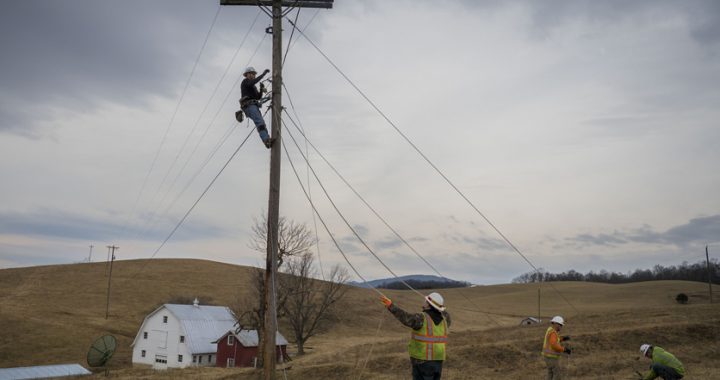News
Broadband in the Region
The CSPDC is providing grant administration support for two infrastructure building broadband projects to benefit the underserved areas of Rockbridge County, including the towns of Goshen and Glasgow Both projects, a Virginia Telecommunication Initiate (VATI) program grant and an Appalachian Regional Commission (ARC) POWER Grant, will total over $3M in funding and will help build strong, competitive communities within this region. The VATI project alone, with a total cost of $4.4 million, will result in 111 miles of gigabit last mile fiber infrastructure that will reach 492 unserved homes and businesses. Local service provider BARC Electric Cooperative is contracted to complete both projects.
Other broadband access efforts in the Region include a project in Augusta County, through a partnership with MGW/Lingo, to construct a fiber-to-the-home network in the McDowell and Deerfield areas of Augusta and Highland Counties. This project totaling over $1M is expected to provide broadband access to 1,099 total locations, including 15 businesses.
On June 17, 2021 the Virginia Department of Housing and Community Development (DHCD) will be hosting an application how-to-apply webinar for the 2022 VATI program. Representatives from units of local government, internet service providers and other interested stakeholders are encouraged to participate. VATI applications are due on September 14, 2021.
Rural Attraction Roundtable
The CSPDC is hosting a second Rural Attraction Roundtable meeting on May 20 to discuss regional teleworking trends and assess the opportunity and best strategies on how to attract remote workers. The Rural Attraction Roundtable will feature a presentation on the Virginia Economic Development Partnership’s National Remote Work Survey, an introduction to the state’s Telework!VA program, and an open discussion for regional stakeholders. For registration information, contact CSPDC Regional Planner Grace Blanchard at grace@cspdc.org.
This meeting is part of the CSPDC’s ongoing economic recovery efforts. For additional resources, upcoming events and data, visit the CSPDC’s COVID-19 Recovery webpage. New information is added regularly.
Ag. Enterprise Center Feasibility Study Final Presentation
The Agricultural Enterprise Center Feasibility Study is in final review and is scheduled to complete in May. Since the study began in July, the CSPDC in partnership with a ten-member study team and consultants New Venture Advisors (NVA), have conducted and completed primary and secondary research that serve as the backbone for the study. From this research, NVA presented three potential operating models to the CSPDC and Study Team in which one, named the “Shenandoah Specialty Meat & Produce Hub” was chosen for further development. The final report will include a financial analysis, building diagram, funding strategy, potential site inventory and operator RFI and will be presented virtually on May 18 to stakeholders, local governments and the general public.
May is National Bike Month
May is National Bike Month – an annual celebration to increase awareness and participation in bicycling, and showcase its many health and environmental benefits. This year, the League of American Bicyclists will be encouraging the pubic to bike ‘anywhere’ and document their ride with use of #BikeThere. Additional days to celebration and bring awareness to bicycling within National Bike Month are National Ride a Bike Day on May 2 and Bike to Work Day on May 21.
The Bike the Valley and RideShare programs, administered by the CSPDC, have created a digital social media campaign to bring public awareness to bicycling in our region. The campaign will be featured throughout the month.
Request for Proposals – CSPDC Regional Pandemic Recovery and Resiliency Plan
The purpose of this Request for Proposal (RFP) is to solicit proposals from which the Central Shenandoah Planning District Commission (CSPDC) may select a firm through competitive negotiation to assist in the development of a regional Pandemic Recovery and Resiliency Plan. This plan is to be used by our local governments, regional leaders, and stakeholders to prevent, prepare for, and respond to the COVID-19 pandemic and similar future events. Funding for this plan is provided through a CARES Act grant from the Economic Development Administration (EDA), U.S. Department of Commerce. Please click here to review the RFP.
Announcements
Please stay tuned for events and more information from the CSPDC.
Archives
- February 2025
- January 2025
- December 2024
- October 2024
- September 2024
- August 2024
- July 2024
- June 2024
- May 2024
- April 2024
- March 2024
- February 2024
- January 2024
- November 2023
- October 2023
- September 2023
- August 2023
- July 2023
- June 2023
- May 2023
- April 2023
- March 2023
- February 2023
- January 2023
- December 2022
- October 2022
- September 2022
- August 2022
- July 2022
- June 2022
- May 2022
- April 2022
- March 2022
- February 2022
- January 2022
- December 2021
- November 2021
- October 2021
- August 2021
- July 2021
- June 2021
- May 2021
- April 2021
- March 2021
- February 2021
- January 2021
- December 2020
- November 2020
- October 2020
- September 2020
- July 2020
- June 2020
- May 2020
- April 2020
- March 2020
- February 2020
- January 2020
- November 2019
- October 2019
- September 2019
- June 2019
- May 2019
- April 2019
- March 2019
- February 2019
- January 2019
- December 2018
- October 2018
- September 2018
- August 2018
- July 2018
- June 2018
- May 2018
- April 2018
- March 2018
- February 2018
- January 2018
- December 2017
- November 2017
- October 2017
- September 2017
- August 2017
- July 2017
- June 2017
- May 2017
- April 2017
- March 2017
- February 2017
- January 2017
- December 2016
- September 2016




